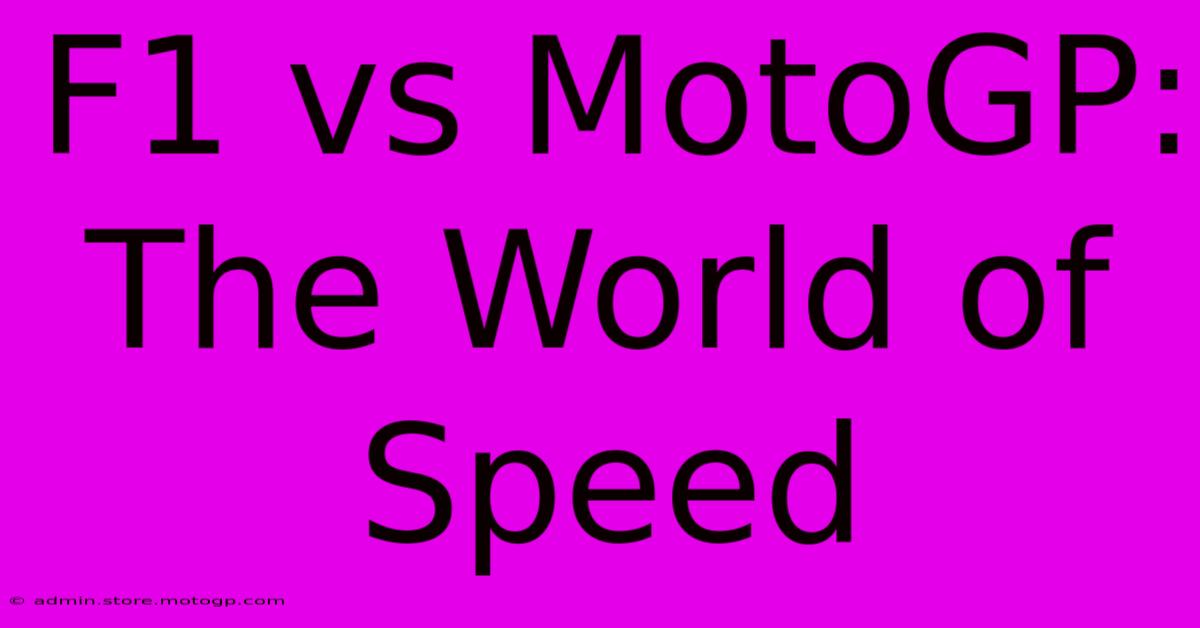F1 Vs MotoGP: The World Of Speed

Table of Contents
F1 vs MotoGP: The World of Speed
For motorsport enthusiasts, the question often arises: F1 or MotoGP? Which is the superior spectacle of speed, skill, and adrenaline? Both Formula 1 and MotoGP represent the pinnacle of their respective disciplines, attracting millions of fans worldwide. But comparing them directly is like comparing apples and oranges – both are fruits, but vastly different in taste and texture. This article delves into the key differences and similarities, helping you understand the unique appeal of each.
The Machines: A Tale of Two Wheels and Four
The most obvious difference lies in the machines themselves. Formula 1 cars are sleek, four-wheeled beasts of engineering, boasting over 1000 horsepower and capable of reaching speeds exceeding 230 mph. Their advanced aerodynamics, complex suspension systems, and sophisticated electronics are testaments to cutting-edge technology. They are machines of pure power and precision, demanding immense skill from their drivers to control their raw force.
MotoGP bikes, on the other hand, are two-wheeled marvels. While horsepower figures are comparable, the challenge is exponentially greater. Riders wrestle with the lean angles, balancing forces, and delicate throttle control required to navigate corners at breakneck speeds. These bikes are incredibly agile but unforgiving, demanding an almost superhuman level of skill, balance, and bravery.
Key Differences in Technology
- Downforce: F1 cars rely heavily on aerodynamic downforce to grip the track at high speeds. MotoGP bikes, with their lighter weight and reliance on tire grip, have minimal aerodynamic aids.
- Braking: F1 cars utilize powerful braking systems designed for high speeds and stopping distances. MotoGP braking is even more demanding, requiring precise control and exceptional rider skill to avoid crashes.
- Tires: F1 tires are designed for specific track conditions and degrade over time. MotoGP tires are similarly crucial and must withstand extreme stress and lean angles.
The Drivers/Riders: Masters of Their Craft
The level of skill required in both F1 and MotoGP is incredibly high, but the nature of the skills differs significantly.
F1 drivers need exceptional car control, race strategy awareness, and mental fortitude to handle the pressure of high-stakes competition. Precision and consistency are key to success.
MotoGP riders require not only exceptional bike control and precision but also a remarkable level of physical fitness and balance. The intense G-forces and physical demands of riding place immense strain on their bodies. Their reflexes and reaction time need to be lightning-fast to react to unpredictable situations.
Human Element Comparison
- Physical Fitness: MotoGP riders require significantly higher levels of physical fitness due to the physical demands of riding.
- Reaction Time: Both require incredible reaction times, but the unpredictable nature of MotoGP often demands even faster reflexes.
- Mental Fortitude: The pressure is immense in both, but the higher risk factor in MotoGP might demand even greater mental resilience.
The Racing: A Different Kind of Thrilling Experience
Both F1 and MotoGP deliver breathtaking racing, but the style and nature of the competition differ.
F1 races are often strategic battles, involving pit stops, tire management, and calculated overtaking maneuvers. The races are generally longer, allowing for more tactical maneuvering.
MotoGP races are often chaotic and unpredictable, featuring close wheel-to-wheel battles and frequent overtaking. The shorter race distances mean less time for strategy and more emphasis on raw speed and skill.
Spectacle and Excitement
- Overtaking: MotoGP frequently features more daring and exciting overtaking maneuvers due to the nature of the bikes and tracks.
- Close Racing: While F1 often has close racing, the intensity and frequency of close battles in MotoGP is often higher.
- Risk vs Reward: MotoGP carries a higher risk element with crashes more common than in F1.
The Verdict: No Clear Winner
Ultimately, deciding whether F1 or MotoGP is "better" is subjective. Both offer unparalleled displays of speed, skill, and technological innovation. The preference boils down to personal taste. Do you prefer the strategic battles of F1 or the chaotic thrill of MotoGP? Both are worth experiencing to appreciate the unique excellence of each. The world of speed has room for both these magnificent sporting disciplines.

Thank you for visiting our website wich cover about F1 Vs MotoGP: The World Of Speed. We hope the information provided has been useful to you. Feel free to contact us if you have any questions or need further assistance. See you next time and dont miss to bookmark.
Featured Posts
-
Experience The Legend Iconic Motorcycle Helmet Replicas
Feb 19, 2025
-
Moto Gp Today Crash Recovery And Return
Feb 19, 2025
-
Yamaha V4 Moto Gp The Art Of Speed And Precision
Feb 19, 2025
-
Moto Gp Arcade Game The Ultimate Test Of Reflexes
Feb 19, 2025
-
Moto Gp Classification Deciphering The Numbers
Feb 19, 2025
